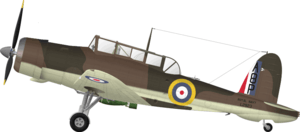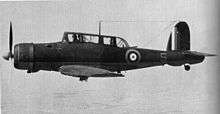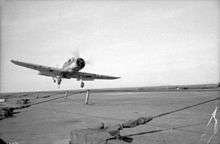Blackburn Skua
| B-24 Skua | |
|---|---|
 | |
| Skua L2923, Red-1 of 803 NAS. One of 16 Skuas from RNAS Hatston to attack and sink the Königsberg in Bergen on 10 April 1940. This aircraft spun out on the return flight and crashed, the only aircraft lost on that day. | |
| Role | Dive bomber / Fighter |
| Manufacturer | Blackburn Aircraft |
| Designer | G.E.Petty |
| First flight | 9 February 1937 |
| Introduction | November 1938 |
| Retired | 1941 (withdrawn from front line) March 1945 (withdrawn from other duties)[1] |
| Primary user | Fleet Air Arm |
| Number built | 192 |
| Variants | Blackburn Roc |
The Blackburn B-24 Skua was a carrier-based low-wing, two-seater, single-radial engine aircraft operated by the British Fleet Air Arm which combined the functions of a dive bomber and fighter. It was designed in the mid-1930s and saw service in the early part of the Second World War. It took its name from the seabird.
Design and development
Built to Air Ministry specification O.27/34, it was a low-wing monoplane of all-metal (duralumin) construction, with a retractable undercarriage and enclosed cockpit. It was the Fleet Air Arm's first service monoplane and was a radical departure for a force that was primarily equipped with open-cockpit biplanes such as the Fairey Swordfish.
Performance for the fighter role was compromised by the aircraft's bulk and lack of power, resulting in a relatively low speed; the contemporary marks of Messerschmitt Bf 109[N 1] made 290 mph (467 km/h) at sea level over the Skua's 225 mph (362 km/h). However, the aircraft's armament of four fixed, forward-firing 0.303 in (7.7 mm) Browning machine guns in the wings and a single flexible, rearward-firing .303 in (7.7 mm) Vickers K machine gun was effective for the time. For dive-bombing role, a 250 lb (110 kg) or 500 lb (230 kg) bomb was carried on a special swinging "trapeze" crutch under the fuselage (somewhat like the Junkers Ju 87), which enabled the bomb to clear the propeller arc on release. Four 40 lb (20 kg) bombs or eight 20 lb (9 kg) Cooper bombs could also be carried in racks under each wing. It had large Zap-type air brakes/flaps, which helped in dive bombing and landing on aircraft carriers at sea.
Two prototypes were ordered from Blackburn in 1935 and the first serial number K5178 first flew on 9 February 1937. Both prototypes were powered by the Bristol Mercury XII radial engine but following trials when a production order for 190 aircraft was placed, they were to have Bristol Perseus XII engines.
Operational history



The first unit to get the Skua was 800 Naval Air Squadron in late 1938 at Worth Down. By November the squadron had embarked on HMS Ark Royal and was followed in 1939 by 801 and 803 squadrons.
With the start of the Second World War, Skuas were soon in action and on 14 September three were launched from Ark Royal, to go to the aid of the SS Fanad Head which had been attacked by a U-boat. When they arrived, the Fanad Head was being shelled by U-30 and all three dived to attack the submarine, which quickly dived to safety. Two of the Skuas were damaged by the blasts and had to ditch. U-30 returned to Germany with the crews of the two ditched Skuas, who became the first naval airmen to be prisoners of war in the conflict.
Skuas were credited with the first confirmed "kill" by British aircraft during the Second World War: a Dornier Do 18 flying boat was shot down over the North Sea on 26 September 1939, by three Skuas of 803 Naval Air Squadron, flying from the aircraft carrier HMS Ark Royal. An earlier victory by a Fairey Battle on 20 September 1939 over Aachen, was later confirmed by French sources.[2] On 10 April 1940, 16 Skuas of 800 and 803 NAS led by Lieutenant Commander William Lucy, flying from RNAS Hatston in the Orkney Islands, sank the German cruiser Königsberg in Bergen harbour during Operation Weserübung, the German invasion of Norway.[3]
This was the first major warship ever to be sunk by dive bombing, indeed the first major warship ever sunk in war by air attack.[4] Lucy later also became a fighter ace flying the Skua. These two mostly Skua squadrons, suffered heavy losses during an attempt to bomb the German battleship Scharnhorst at Trondheim on 13 June 1940; of 15 aircraft in the raid, eight were shot down and the crews killed or taken prisoner. Among the latter were both squadron commanders, Captain R. T. Partridge (RM) and Lieutenant Commander John Casson (RN).[5][6]
Although it fared reasonably well against Axis bombers over Norway and in the Mediterranean, the Skua suffered heavy losses when confronted with modern fighters - particularly the Bf 109 - and they were withdrawn from front line service in 1941. The aircraft was largely replaced by another two-seater, the Fairey Fulmar, which doubled the Skua's forward armament and had a speed advantage of 50 mph (80 km/h). A number of aircraft were converted to target tugs, following withdrawal from front line service. Others were completed as target tugs from the factory and used by the RAF and Fleet Air Arm in this role ("Fleet Requirements").[1] They were also used as advanced trainers for the Fleet Air Arm. The last Skua in service was struck off charge in March 1945.[7]
The Roc was a very similar aircraft developed as a turret fighter, with all its armament in a dorsal turret. The Roc was expected to serve alongside the Skua. Rocs were attached to Skua squadrons, to protect the fleet anchorage at Scapa Flow in early 1940 and briefly from HMS Glorious and Ark Royal during the Norwegian Campaign. Skuas and Rocs flew fighter sweeps and bombing sorties over the English Channel during Operation Dynamo and Operation Ariel, the evacuations of Allied forces from Dunkirk and other French ports.[8]
Variants
- Skua Mk.I : two prototypes. Powered by the Bristol Mercury, it had distinctive fairings to the engine cowling over the tappet valves of the Mercury. The first prototype, K5178, had a much shorter nose while K5179, the second prototype, had a lengthened nose to improve longitudinal stability.
- Skua Mk.II : Production aircraft powered by the sleeve valved Bristol Perseus. Long nose as per K5179 but with a shorter, smooth cowling. Two-seat fighter and dive bomber for the Royal Navy; 190 built by Blackburn at Brough Aerodrome.
Surviving Aircraft
No intact Skuas survive. In April 2007, the only known nearly complete Blackburn Skua, was discovered in Orkdalsfjorden in Norway at 242 metres (794 ft) depth.[9] Due to an engine failure, the Skua, flown by John Casson, leader of 803 Squadron, had to make an emergency water landing in the fjord.[10] Both crew members survived and spent the next five years as prisoners of war. Despite efforts to get the aircraft to the surface as gently as possible, the tail broke off. The engine had become detached in the ditching. The fuselage, cockpit and wings were salvaged. The Skua will be restored at Norway's aviation museum in Bodø.[11][12]
In 1974, L2940 was recovered from Breidalsvatnet lake, near Grotli in Skjåk municipality. Captain R. T. Partridge (RM) shot down a Heinkel He 111 and then made an emergency landing on the ice-covered lake on 27 April 1940. Survivors from both aeroplanes independently made their way to a mountain lodge, where they encountered each another. This incident serves as the basis for the film Into the White.[13]
Operators and units
- Royal Air Force
- RAF Anti-Aircraft Co-operation Units
Specifications (Skua Mk. II)

Data from Blackburn Aircraft since 1909[14]
General characteristics
- Crew: 2
- Length: 35 ft 7 in (10.85 m)
- Wingspan: 46 ft 2 in (14.08 m)
- Height: 12 ft 6 in (3.81 m)
- Wing area: 319 sq ft (29.6 m2)
- Empty weight: 5,496 lb (2,498 kg)
- Loaded weight: 8,228 lb (3,740 kg)
- Powerplant: 1 × Bristol Perseus XII radial engine, 890 hp (664 kW)
Performance
- Maximum speed: 225 mph (196 knots, 362 km/h) at 6,500 ft (1,980 m)
- Cruise speed: 187 mph[15] (163 knots, 301 km/h)
- Range: 435 mi (378 nmi, 700 km)
- Service ceiling: 20,200 ft (6,160 m)
- Rate of climb: 1,580 ft/min (8.0 m/s)
Armament
- Guns: [16]
- 4 × 0.303 in (7.7 mm) forward-firing Browning machine guns
- 1 × 0.303 in (7.7 mm) Lewis or Vickers K machine gun on flexible mount in rear cockpit
- Bombs: 1 × 500 lb (227 kg) semi-armour piercing bomb under fuselage or 8 × 30 lb (14 kg) practice bombs under wings[16]
See also
- Related development
- Aircraft of comparable role, configuration and era
- Related lists
- List of aircraft of the Fleet Air Arm
- List of aircraft of the Royal Air Force
- List of bomber aircraft
- List of aircraft of World War II
References
- Notes
- ↑ Messerschmitt Bf109E with DB601A engine
- Citations
- 1 2 "Blackburn Skua aircraft profile." Fleet Air Arm Archive via fleetairarmarchive.net,3 April 2000. Retrieved: 8 November 2010.
- ↑ Jeremy Beadle and Ian Harrison Firsts, Lasts & Onlys - Military, Anova Books 2008 ISBN 1905798067 (p.125)
- ↑ Mondey 1994, p. 36.
- ↑ Dell, John. "The Sinking of the Königsberg." Dinger's Aviation Pages. Retrieved: 5 May 2009.
- ↑ Dell, John. "Skuas Over Norway." Dinger's Aviation Pages. Retrieved: 5 May 2009.
- ↑ Willis and Partridge 2007, p. 26.
- ↑ Willis Aeroplane December 2007, p. 68.
- ↑ Dell, John. "Skuas over Dunkirk." freespace.virgin.net. Retrieved: 8 November 2010.
- ↑ "Skua 31 May 2007." Aeroplane, July 2007. Retrieved: 13 April 2008.
- ↑ "Operation Skua 2010." Operation Skua. Retrieved: 8 November 2010.
- ↑ Tvedten, Hilde Marie. "Her er det siste Blackburn Skua-flyet i verden" (in Norwegian) Article in Dagbladet, Norway newspaper. dagbladet.no. Retrieved: 8 November 2010.
- ↑ "Skua." Norway's Aviation Museum. Retrieved: 8 November 2010.
- ↑ NRK. "Naudlanding og kampar på Strynefjellet". Retrieved 22 July 2012.
- ↑ Jackson 1968, p. 407.
- ↑ Lumsden and Heffernan Aeroplane Monthly March 1990, p. 150.
- 1 2 Jackson 1968, p. 401.
- Bibliography
- Brown, Eric, CBE, DCS, AFC, RN., William Green and Gordon Swanborough. "Blackburn Skua and Roc." Wings of the Navy, Flying Allied Carrier Aircraft of World War Two. London: Jane's Publishing Company, 1980, pp. 29–40. ISBN 0-7106-0002-X.
- Jackson, A.J. Blackburn Aircraft since 1909. London: Putnam & Company Ltd., 1968. ISBN 0-370-00053-6.
- Lumsden, Alec and Terry Heffernan. "Probe Probare: Blackburn Skua and Roc Part Two". Aeroplane Monthly,March 1990, Vol. 18, No. 3. pp. 146–150.
- Mondey, David. The Hamlyn Concise Guide to British Aircraft of World War II. London: Chancellor Press, 1994. ISBN 1-85152-668-4.
- Partridge, Major R.T., DSO, RM. Operation Skua. Ilchester, Somerset, UK: Society of the Friends of the Fleet Air Arm Museum, RNAS Yeovilton, 1983. ISBN 0-902633-86-4.
- Smith, Peter C. History of Dive-Bombing: A Comprehensive History from 1911 Onward . Barnsley, South Yorkshire, UK: Pen and Sword, 2007. ISBN 1-84415-592-7.
- Smith, Peter C. Skua! the Royal Navy's Dive-Bomber. Barnsley, South Yorkshire, UK: Pen and Sword, 2006. ISBN 1-84415-455-6.
- Willis, Matthew. Blackburn Skua and Roc. Sandomierz, Poland/Redbourn, UK: Mushroom Model Publications, 2007. ISBN 83-89450-44-5.
- Willis, Matthew. "Database: The Blackburn Skua & Roc". Aeroplane, December 2007, Vol. 35, No. 12, pp. 52–69.
- Willis, Matthew and Simon Partridge. "Into the Fjord of Death". Aeroplane, August 2007, Vol. 35, No. 8, pp. 22–27.
External links
| Wikimedia Commons has media related to Blackburn Skua. |
| ||||||||||